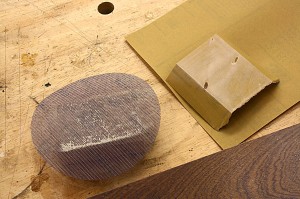We may receive a commission when you use our affiliate links. However, this does not impact our recommendations.
 The most beneficial discoveries come when you least expect them. Last week as I wrapped up finish on the desk for the November issue and from our upcoming book “Furniture in the Southern Style”, I was about to sand my first couple coats of shellac. I dug through my sandpaper drawer and soon found out that I was out of #400-grit and #320-grit sandpaper, which I use when knocking down shellac or sealer.
The most beneficial discoveries come when you least expect them. Last week as I wrapped up finish on the desk for the November issue and from our upcoming book “Furniture in the Southern Style”, I was about to sand my first couple coats of shellac. I dug through my sandpaper drawer and soon found out that I was out of #400-grit and #320-grit sandpaper, which I use when knocking down shellac or sealer.
There is a hardware store right across the road from my shop, but I was not looking to waste any time running over for sandpaper. On the shelf behind my bench, I have boxes of Mirka abranet – If you’ve read these blogs for any length of time, you know that Popular Woodworking Magazine is a huge fan of abranet. We have sung its praises since we first had the product dropped in our shop.
In my arsenal of abranet, I have a box of #400-grit discs. Why not give it a try.
It took about an entire two minutes before I slapped my forehead in a Homer Simpson manner and utter the words, “D’oh!” I sanded the shellac and, of course, the disc loaded fully. With regular sandpaper, that would be the end unless I grabbed my air hose and blew the crap out of the things to unclog the paper. With the abranet, I simply rapped the disc on my hand and it was almost totally clean.
Later, as I blocked the piece to get a level surface, the differences between abranet and paper became more obvious. The additional heat build-up when sanding with a block tends to clog paper quickly. With abranet, because it does not have a solid backing, the heat build-up is not as severe, so discs don’t clog they load.
Take a look at the opening photo. In it you see a quickie experiment I ran to make a comparison of sandpaper versus abranet. I sanded finish with each of the products for a dozen strokes. You can see that the paper is loaded and the abranet does have a substantial amount of shellac dust.
 The photo to the right shows the results after the two are cleaned by simply smacking them against my hand. It’s pretty clear as to which product is going to last longer and provide a better sanded surface. The same results show up when sanding with a foam-core block, so on my next project I’ll grab a pad protector, attach a disc and get busy.
The photo to the right shows the results after the two are cleaned by simply smacking them against my hand. It’s pretty clear as to which product is going to last longer and provide a better sanded surface. The same results show up when sanding with a foam-core block, so on my next project I’ll grab a pad protector, attach a disc and get busy.
What’s even better is how the abranet compares to sandpaper if you get on the finish before it’s fully dry – you know that I did and I’ll bet you too have gummed up paper attempting to level your finish early. If you do get going a bit early while using abranet, you can clear the gummed mess off by blowing air through the backside of the disc. Sandpaper goes to the trash.
Unless you change block locations frequently, there is some wasted real estate when block sanding with a disc. I guess on my next abranet order, I’ll add a couple boxes of sheets to the list.
Looking for additional information on sanding and prepping surfaces for finish? Here’s a couple down loadable $2 articles that could answer many of your questions:
Here are some supplies and tools we find essential in our everyday work around the shop. We may receive a commission from sales referred by our links; however, we have carefully selected these products for their usefulness and quality.









I have experienced adverse results using Abranet. I use the recomended Abranet felt pad between the Abranet and the hook pad on the sander. The Abranet simply destroys the sander’s hook pad. This is a Porter Cable random orbit sander. Has anyone else had this problem?
Glen,
If you find a source for SHEETS of the Abranet, please post it! I want it but can’t find it.
Mike D
Another note: Abranet has a grain… folds easier in one direction and cuts differently than the other. So, by turning the sanding block 90 degrees, you get more aggresive sanding.
I have been doing this for years… never throw away old Abranet… worn out 240 or 320 is perfect for smoothing out sanding sealer or prep for that last coat of lacquer. Even add a layer of thin padding under the Abranet to keep the square block edges under control. Just blow of with compressed air when it looks like it is starting to clog. Cheers and happy sanding!
I was interested in the articles supporting this piece; Flexner on Finishing: Rules for Sanding Wood
Sanding Finishes by Robert W. Lang
It would be most helpful to your Gentle Readers if the issue number/date was included. I subscribe to the magazine and have since it began. It would be helpful to know which issue to look in rather than having to sort through the full stack to find the article.
Just a thought about how you can make your subscribers happy.
Cheers,
John
When my wife and I first joined households, we merged two tool collections. (I have the best wife) I ended up with a surplus of sanding discs (alas, no Abranet, but I do love the stuff.) But I find I hand sand a lot more than I use a disc sander. The obvious answer was to make a couple a sanding “puck” with half of some heavy duty hook and loop fastener stuff on one side and a nice handle. I still prefer sheets, but it’s quite handy to have around.
Gee, Glen, I didn’t think you sanded past 180 grit. You better watch out. With the mirka abranet, you’re likely to get tennis elbow.